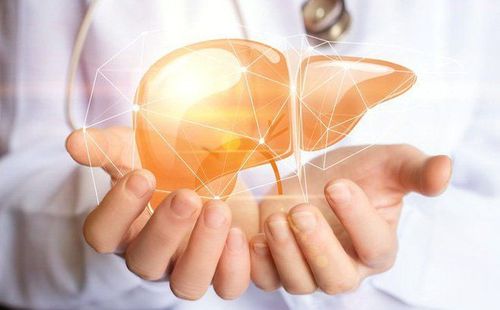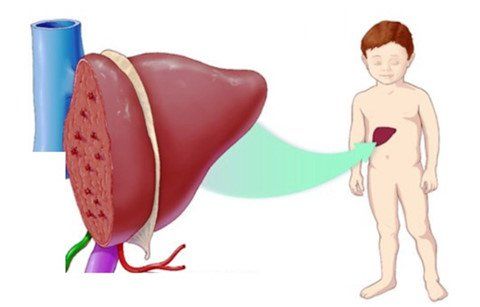This is an automatically translated article.
The article was professionally consulted with Specialist II Cao Thi Thanh - Pediatrician - Pediatrics - Neonatology - Vinmec Hai Phong International General Hospital.Neonatal cholestasis is usually caused by congenital anomalies or atrophy of the biliary tree. The prominent clinical symptom of the disease is generalized jaundice. The disease can be completely resolved without leaving serious sequelae if diagnosed and treated early.
1. Anatomy of the biliary system
The biliary system is divided into intrahepatic and extrahepatic biliary tracts. The intrahepatic bile ducts are formed by the union of bile ducts from the liver lobes. It is then poured into the right and left hepatic ducts. The extrahepatic biliary tract includes the extrahepatic segments of the right and left hepatic ducts, the common hepatic duct, and the cystic duct, which drains into the common bile duct to the D2 segment of the duodenum.2. The phenomenon of cholestasis in infants
Cholestasis is a blockage at any site of the biliary system, making the amount of bilirubin excreted cannot reach the digestive tract but stagnate in the biliary tract, thereby leading to some local symptoms. or excreted into the blood, causing generalized jaundice in the newborn.The incidence of neonatal cholestasis is relatively low, accounting for 1/2500 of all term neonates. Definition of cholestasis as direct bilirubin > 1 mg/dL in blood. This is a disease, so it is necessary to carry out exploratory tests to diagnose and treat early, to avoid leaving severe sequelae for children.

3. Causes of cholestasis in infants
3.1. Cholestatic atrophy Biliary atrophy is the most common clinical cause of cholestatic jaundice in neonates. The cause is due to fibrosis of the biliary tree, narrowing the lumen, so bile cannot flow.Clinical symptoms of this disease appear a few weeks after birth. The exact cause is unknown, but according to studies, infants with neonatal sepsis are associated with biliary atresia.
3.2. Disorders of synthesis of bile in the liver Infection is the most common cause, some viruses such as rubella, HSV, CMV, bacteria such as E.coli, parasites such as toxoplasma will cause biliary obstruction. Microorganisms can enter the baby's body because the mother has previous infections, the mother has a vaginal infection and gives birth via vaginal delivery, or microorganisms present in breast milk.
3.3. Autoimmune liver disease causing cholestasis in newborns Autoimmune liver disease is an inherited disease caused by maternal IgG passed to the infant during pregnancy, creating immune complexes that destroy liver cells. This pathology can also be the cause of cholestasis in infants.
3.4. Metabolic disorders Congenital disorders of metabolism such as galactosemia, alpha-1 antitrypsin deficiency, tyrosine deficiency, mitochondrial disorders, dyslipidemia and disrupted fatty acid oxidation. Some of the more common diseases associated with this problem are cystic fibrosis and spasticity - renal failure - cholestatic jaundice (ARC).
3.5. Gene Mutations There are several gene mutations that will cause disorders of bile secretion and lead to cholestasis. The disease is related to family factors.

4. Symptoms of cholestasis in infants
Conjugated bilirubin is still synthesized by the liver, but cannot be excreted in the gastrointestinal tract, causing absorption disorders due to lack of bile and bile salts. Children will have malabsorption of fat-soluble vitamins A, D, E, K and nutritional deficiencies. Children's stools will become discolored (also known as stork droppings) because of a lack of synthetic bilirubin (the substance that gives stools a yellow color).Bilirubin stagnation will enter the blood to increase the concentration of total Bilirubin, causing neonatal jaundice. To distinguish physiological jaundice and pathological jaundice is mainly based on the time of disease and the duration of the disease. Physiological jaundice appears a few days after birth and will disappear on its own after 1 week. Pathological jaundice appears about 2 weeks after birth and lasts for a long time, gradually increasing jaundice, accompanied by dark urine and pale stools.
In the later stages of the disease may add symptoms of ascites, portal hypertension causing gastrointestinal bleeding, collateral circulation.
Diagnostic tests for cholestasis in neonates:
Complete peripheral blood count to assess for infection; Blood clotting function; Quantitative testing of total and conjugated Bilirubin levels in the child's blood; Liver function tests: AST, ALT, alkaline phosphatase, blood albumin; Specific testing for metabolic and genetic causes; Ultrasound of the liver and biliary system.

5. Treatment of cholestasis in infants
Treatment of symptoms of cholestasis in infants:Phototherapy to increase the breakdown of Bilirubin reduces the concentration of Bilirubin in the blood. Supplement with vitamins A, D, E, K. If the baby uses formula milk, it is recommended to choose a milk with a high content of medium chain triglycerides because it is easier to absorb when the child is in a state of lack of bile salts, this help children not have nutritional deficiencies Treat causes of cholestasis in infants:
Thoroughly resolve the pathology and do not recur: Can be treated medically in case of metabolic disorders or congenital deficiencies biosynthesis of bile. If there are antibodies that cause liver damage, consider dialysis for the child. Surgical treatment of congenital biliary atresia, congenital biliary malformation. In summary, if cholestasis in infants is not diagnosed and treated early, it will lead to hepatitis, cirrhosis, gastrointestinal bleeding due to esophageal varices, and even death. Therefore, when the signs of the disease are suspected, it is necessary to diagnose and thoroughly treat the cause to help the child completely recover from the disease, grow and develop normally.
Currently, the Pediatrics Department at Vinmec International General Hospital is trusted by many parents to examine the diseases that babies and children have. Vinmec brings satisfaction to customers and is highly appreciated by industry experts by:
Gathering a team of leading pediatricians: including leading experts with high professional qualifications ( professor, associate professor, doctorate, master), experienced, worked at major hospitals such as Bach Mai, 108... The doctors are well-trained, professional, conscientious - understanding and understanding young psychology. Besides domestic pediatricians, the Department of Pediatrics also has the participation of foreign experts (Japan, Singapore, Australia, USA) who are always pioneers in applying the latest and most effective treatment regimens. . Comprehensive services: In the field of Pediatrics, Vinmec provides a series of continuous medical examination and treatment services from Newborn to Pediatric and Vaccine,... according to international standards to help parents take care of their baby's health from birth to childhood. Advanced techniques: Vinmec has successfully deployed many specialized techniques to make the treatment of difficult diseases in Pediatrics more effective: neurosurgery - skull surgery, stem cell transplantation blood in cancer treatment. Professional care: In addition to understanding children's psychology, Vinmec also pays special attention to the children's play space, helping them to play comfortably and get used to the hospital's environment, cooperate in treatment, improve the efficiency of medical treatment.
Please dial HOTLINE for more information or register for an appointment HERE. Download MyVinmec app to make appointments faster and to manage your bookings easily.














